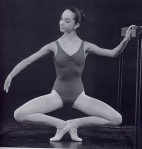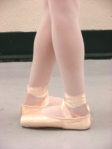Hahaha-Hai!
It’s still 24 Aug 2011, Yet I reaaallyy want to see how my blog’s look like if it has posts on it 😉 . Errr… Since I don’t know what else to write, I’m going to start with this category : “Vocabulary”. (Whew … by establishing this category I suddenly burdened to – consistently- write posts of ballet movements names and explain how it’s being executed . I will try though 🙂
So, This day I am going to write about the most basic and most important movement in ballet or maybe in any dance field. It is called “Plie” . In Classical Ballet Dictionary (by Rhonda Ryman) says that Plie is ; To Bend ; bending action; bending of the knees.

Plie
This is how we do Plie; Knees are opened, heels stay on floor, feel the back spine lengthened upward as you go down, and never tuck your buttock wrongly, cause it won’t give any perfect line and won’t be effective in strengthening your thigh and abdominal muscles.

Grand Plie
After Plie usually we continue moving with a movement called “Grand Plie”, which in the same dictionary Grand Plie means ; A full bend of the knees over toes, with the legs turned out and the heels coming off the floor, except in 2nd and 4th open positions.
Technically its effect is the same as Plie, also, it helps you stretch the Achilles tendon. So be free to feel each muscles work as you do it (you can see how the girl in picture keep her upper body stays up and centered while she goes down), and oh please don’t ever bothered by the height of heels as they come off the floor cause it’s simply just come off the floor as you bend deeper and deeper. The height of heel is not essential and artificial (I got to tell this cause most kids have tendency to do it ‘artificially’ the first time they do grand plie).

Achilles tendon
So, basically Plie (and/ or Grand Plie) is one of stretching movement that help you warm up and stretch the Achilles tendon and other muscles attached in your leg , and also strengthening your core, abdominal and thigh muscles. This is why I say it is the most important movement, cause being strong and treat your body right is all you need to be on stage 😉 .
That’s a wrap, and See you ! 😀
P.S: I tried to find pictures with the most correct body placement in doing the Plie and Grand Plie , so i thank you for every person who happen to own the pictures and link addressed 🙂










